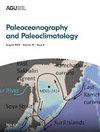浮游生物对与PETM相关的环境变化的恢复力
IF 3.2
2区 地球科学
Q2 GEOSCIENCES, MULTIDISCIPLINARY
引用次数: 0
摘要
碳酸盐形成生物在海洋无机碳循环中发挥着不可或缺的作用,但对碳酸盐生产与环境之间的联系还不够了解。碳酸盐的产生是由钙化物的丰度和每个个体产生的方解石的数量(其大小和重量)驱动的。在这里,我们研究了大西洋、太平洋和南大洋的有孔虫碳酸盐产量如何在古新世-始新世热盛期(PETM)期间因4–5°C的变暖和0.3的表层海洋pH值降低而发生变化。为了将这些本地数据放在全球背景下,我们首次将基于特征的浮游生物模型(ForamEcoGEnIE)应用于地质记录。我们的数据表明,有孔虫的组合测试大小和丰度变化可以忽略不计。ForamEcoGEnIE解决了规模和生物量的小幅减少,但这些都是短期的。有孔虫的反应显示了与变暖引起的极地迁移有关的空间变异性,并表明公海和大陆架位置之间的营养物质可用性存在差异。尽管高纬度地区的方解石饱和度较低,但我们重建了稳定的有孔虫大小归一化重量。基于这些发现,我们推测,在PETM期间,海面变暖对有孔虫碳酸盐岩生产的影响比海洋酸化更大。大块碳酸盐组成的变化表明,在PETM期间,球石藻比有孔虫对环境变化的敏感性更高。本文章由计算机程序翻译,如有差异,请以英文原文为准。
Planktic Foraminiferal Resilience to Environmental Change Associated With the PETM
Carbonate‐forming organisms play an integral role in the marine inorganic carbon cycle, yet the links between carbonate production and the environment are insufficiently understood. Carbonate production is driven by the abundance of calcifiers and the amount of calcite produced by each individual (their size and weight). Here we investigate how foraminiferal carbonate production changes in the Atlantic, Pacific and Southern Ocean in response to a 4–5°C warming and a 0.3 surface ocean pH reduction during the Palaeocene‐Eocene Thermal Maximum (PETM). To put these local data into a global context, we apply a trait‐based plankton model (ForamEcoGEnIE) to the geologic record for the first time. Our data illustrates negligible change in the assemblage test size and abundance of foraminifers. ForamEcoGEnIE resolves small reductions in size and biomass, but these are short‐lived. The response of foraminifers shows spatial variability linked to a warming‐induced poleward migration and suggested differences in nutrient availability between open‐ocean and shelf locations. Despite low calcite saturation at high latitudes, we reconstruct stable foraminiferal size‐normalized weight. Based on these findings, we postulate that sea surface warming had a greater impact on foraminiferal carbonate production during the PETM than ocean acidification. Changes in the composition of bulk carbonate suggest a higher sensitivity of coccolithophores to environmental change during the PETM than foraminifers.
求助全文
通过发布文献求助,成功后即可免费获取论文全文。
去求助
来源期刊

Paleoceanography and Paleoclimatology
Earth and Planetary Sciences-Atmospheric Science
CiteScore
6.20
自引率
11.40%
发文量
107
期刊介绍:
Paleoceanography and Paleoclimatology (PALO) publishes papers dealing with records of past environments, biota and climate. Understanding of the Earth system as it was in the past requires the employment of a wide range of approaches including marine and lacustrine sedimentology and speleothems; ice sheet formation and flow; stable isotope, trace element, and organic geochemistry; paleontology and molecular paleontology; evolutionary processes; mineralization in organisms; understanding tree-ring formation; seismic stratigraphy; physical, chemical, and biological oceanography; geochemical, climate and earth system modeling, and many others. The scope of this journal is regional to global, rather than local, and includes studies of any geologic age (Precambrian to Quaternary, including modern analogs). Within this framework, papers on the following topics are to be included: chronology, stratigraphy (where relevant to correlation of paleoceanographic events), paleoreconstructions, paleoceanographic modeling, paleocirculation (deep, intermediate, and shallow), paleoclimatology (e.g., paleowinds and cryosphere history), global sediment and geochemical cycles, anoxia, sea level changes and effects, relations between biotic evolution and paleoceanography, biotic crises, paleobiology (e.g., ecology of “microfossils” used in paleoceanography), techniques and approaches in paleoceanographic inferences, and modern paleoceanographic analogs, and quantitative and integrative analysis of coupled ocean-atmosphere-biosphere processes. Paleoceanographic and Paleoclimate studies enable us to use the past in order to gain information on possible future climatic and biotic developments: the past is the key to the future, just as much and maybe more than the present is the key to the past.
 求助内容:
求助内容: 应助结果提醒方式:
应助结果提醒方式:


